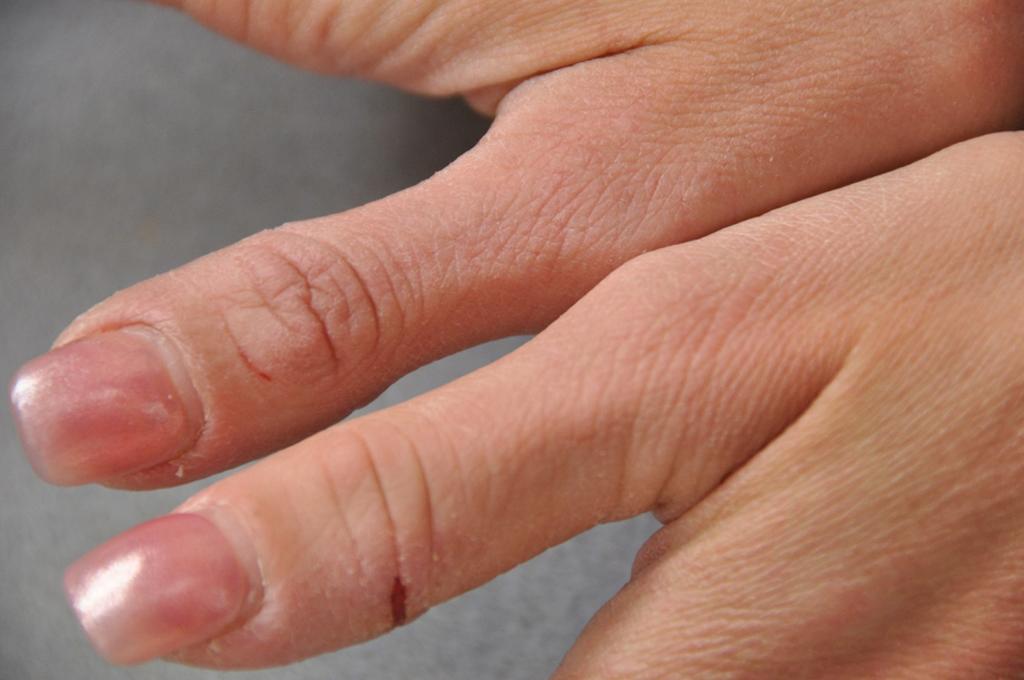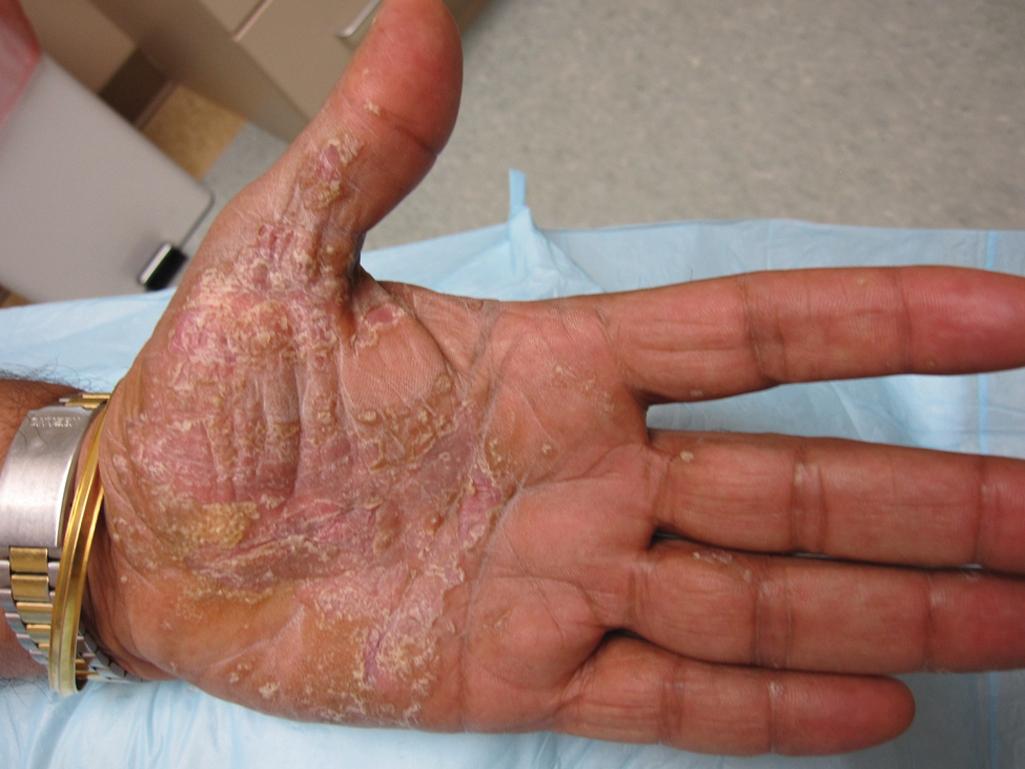Physical Address
304 North Cardinal St.
Dorchester Center, MA 02124
Hand dermatitis is extremely common because the hands are exposed to many environmental chemicals and irritants.
The severity of hand dermatitis ranges dramatically from mild scaling in the absence of erythema to the presence of deep fissures ( Fig. 4.1 ).

The vast majority (around 90%) of hand dermatitis cases are irritant contact dermatitis (ICD), with a minority of patients presenting with allergic contact dermatitis (ACD).
ACD frequently occurs in patients with underlying ICD.
Patients with chronic hand dermatitis that becomes unresponsive to treatment over time frequently have developed superimposed ACD.
There is no clinical finding that definitively distinguishes hand ACD from hand ICD.
The most common irritants implicated in hand dermatitis are water (from hand washing or wet work) and hand soap.
The groups at the highest risk for developing hand dermatitis include hairdressers, mechanics, house or office cleaners, mothers of young children, healthcare workers, and those with atopic dermatitis (AD).
Most hand dermatitis results from repetitive low-grade irritant insults (e.g., hand washing).
Hand dermatitis typically is more bothersome to patients than dermatitis elsewhere because it can significantly affect activities of daily living.
Hand dermatitis is more common in individuals with underlying AD.
Patients with AD who develop hand dermatitis may have concomitant components of ICD and ACD.
Isolated hand dermatitis is not a common manifestation of AD.
Another less common, but typically more severe, subtype of hand dermatitis is dyshidrotic eczema.
Dyshidrotic eczema is an extremely pruritic hand (and sometimes foot) dermatitis variant characterized by the development of small blisters predominantly on the lateral aspects of the fingers.
Despite its name, it is not definitively linked to sweating.
Patients with dyshidrotic eczema frequently describe pruritus out of proportion to examination findings.
The differential diagnosis for hand dermatitis can be divided into true dermatitis (ICD, ACD, AD, dyshidrotic eczema, or nummular dermatitis) and other nondermatitic infection and inflammatory conditions, such as palmoplantar psoriasis, tinea manuum, and contact urticaria. As was previously mentioned, clinical examination alone is often insufficient for distinguishing the different types of true hand dermatitis from each other, with the exception of nummular dermatitis and dyshidrotic eczema, which have skin features that differentiate them from the other diagnoses.
Nummular hand dermatitis typically presents as circular, erythematous plaques on the dorsal hands that are stable in size and exquisitely pruritic. Examination of the extremities will often reveal lesions of a similar morphology.
Palmoplantar psoriasis ( Fig. 4.2 ) typically affects both palms and soles with hyperkeratotic plaque, which may or may not have overlying silver-white scale with minimal itch. The presence of large, sterile pustules is characteristic of some forms of palmoplantar psoriasis. Psoriasis may also be present on other extensor surfaces, the scalp, and the lower back. Nail psoriasis is almost always identifiable in cases of palmoplantar psoriasis.

Tinea manuum is a dermatophyte (fungal) infection that generally only affects the palmar surfaces. It presents predominantly with diffuse scaling, with or without background erythema; however, occasionally it can look like classic ringworm and involve the dorsum of the hand. Onychomycosis of the involved hand and bilateral feet is also often observed. Additionally, examination of the feet is useful because most patients have concomitant bilateral tinea pedis (a two-feet, one-hand presentation).
Contact urticaria is an acute allergic reaction that involves the abrupt onset of wheals, burning, stinging, and swelling over areas that come into contact with an environmental allergen. When their use was commonplace, latex gloves were a frequent cause of contact urticaria. Food handling is now a more common cause.
Id reactions are secondary papulovesicular eruptions that occur as the result of a primary skin condition on another area of the body and should be suspected if an initial skin lesion (e.g., tinea, ACD, or stasis dermatitis) is identified at a separate site. Id reactions rarely localize exclusively to the hands and more commonly involve the dorsal hands and extensor forearms simultaneously.
Hand dermatitis is typically a clinical diagnosis. All patients with hand dermatitis should have their nails and feet examined. A total-body skin examination for identification of rash elsewhere is also helpful.
History taking should be directed at assessing personal and occupational habits to identify potential irritants or allergens.
Patients should be questioned regarding exposure to potential irritants or allergens, keeping in mind that occupational and nonoccupational allergens may differ slightly.
The most common workplace allergens causing hand ACD include first aid medications, metallic salts, organic dyes, plants, and rubber additives.
The most common nonoccupational allergens causing hand ACD are nickel, fragrances, cosmetic agents, and preservatives.
Common irritants implicated in hand ACD include detergents, chemicals in household cleaning agents, mild soaps (with repetitive use), metal tools, fiberglass, wood shavings, and dust.
Professionals at high risk for exposure to irritants and allergens include hairdressers, cement workers, food processors, florists, chefs, builders, medical workers, and painters.
Frequent hand exposure to wet environments (more than 2–3 hours per day), skin trauma, vibration, or pressure can compromise protective barriers in the skin and increase the likelihood of developing either ICD or ACD.
Because ICD cannot be reliably differentiated from ACD based on examination alone, patch testing to assess for contact allergies is recommended in all patients refractory to conservative measures.
Prick testing is not a replacement for patch testing because it does not assess for Type IV hypersensitivity reactions.
Because patch testing cannot be used to identify irritant exposures, consulting workplace materials safety data sheets may prove helpful in these cases.
In all cases of hand dermatitis, a skin biopsy is rarely necessary and typically is not helpful in differentiating between various types of hand dermatitis.
In cases where tinea manuum is in the differential diagnosis, obtaining a scraping for fungal culture can be fruitful.
Regardless of the particular etiology, treatment of hand eczema requires a multifaceted approach, involving 1) skin barrier restoration/maintenance; 2) behavioral changes to protect against insults to the skin barrier; and 3) the use of antiinflammatory prescription medications (e.g., topical corticosteroids, topical calcineurin inhibitors, systemic immunosuppressants).
Become a Clinical Tree membership for Full access and enjoy Unlimited articles
If you are a member. Log in here